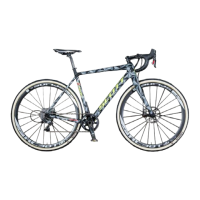ENGLISHENGLISH
37 |
ROAD BIKE | OWNER’S MANUAL 2017OWNER’S MANUAL 2017 | ROAD BIKE
| 36
DANGER!
G
The setting range of the saddle is very small. Replacing the stem allows you
to make far bigger adjustments to the rider’s fore-to-aft position, as stems
come in different lengths. In doing so you may achieve differences of more than
ten centimetres. In this case you usually would have to adjust the length of the
cables – a job best left to your SCOTT dealer!
NOTE!
I
The manufacturers of saddles deliver their products with detailed manuals.
You find these manuals on this SCOTT info CD. Read them carefully before
adjusting the position of your saddle. If you are in doubt or if you have any ques-
tions, contact your SCOTT dealer.
Adjustment of saddle position and tilt
With patent seat posts (d) one or two bolts fix the clamping mechanism, which
controls the tilt and the horizontal position of the saddle. Some seat posts have
two bolts side-by-side.
Release the bolt(s) at the top of the seat post. Release the bolt(s) two to three
turns anticlockwise at the most, otherwise the whole assembly can come apart.
Move the saddle forth or back, as desired. You may have to give the saddle a
light blow to make it move.
Please observe the markings on the saddle rail. Make sure the seat of the saddle
remains horizontal (e) as you retighten the bolt(s). Your SCOTT bike should
stand on level ground while you adjust the saddle.
Having found your preferred position, make sure both clamp halves fit snugly
around the saddle rails before tightening the bolt(s) to the correct torque value
as prescribed by the seat post manufacturer.
Retighten the bolt(s) with a torque wrench according to the manuals of the
manufacturer. After fastening the saddle, check whether it resists tilting by
bringing your weight to bear on it once with your hands at either end of the
saddle (f).
DANGER!
G
Modifications in the area of the carbon forks are jobs which should be left
to a skilled two-wheel/bicycle mechanic. SCOTT therefore recommends
that you ask your SCOTT dealer to do any work on the carbon fork, whenever
necessary. Wrong processing and unfavourable stems may lead to breakage.
Risk of accident!
DANGER!
G
Sawdust from cutting carbon components has a reputation of causing can-
cer. Therefore, do not blow or sweep the dust off, but remove it with a moist
rag. Dispose of it immediately.
SADDLE ADJUSTMENT – FORE-TO-AFT POSITION AND HORIZONTAL
TILT
The inclination of your upper body (a), and hence your riding comfort and
pedalling power, are also influenced by the distance between the grips of the
handlebars and the saddle. This distance can be altered slightly by changing the
position of the saddle rails in the seat post clamp. However, this also influences
your pedalling. Whether the saddle is positioned more to the front or to the
back of the bike will alter how rearward the pedalling position of your legs is.
Make sure the saddle is clamped within the range of the marking on the saddle
rail, i.e. on the straight part of the rail, never in the curved sections.
You need to have the saddle horizontal in order to pedal in a relaxed manner.
If it is tilted, you will constantly have to lean against the handlebars to prevent
yourself from slipping off the saddle.
DANGER!
G
The bolted connections of the seat post have to be tightened to the pre-
scribed torque values (b). Use a torque wrench and never exceed the max-
imum torque values! You will find the prescribed values in the chapter “Recom-
mended torque settings for your SCOTT bike”, directly on the components and/
or in the manuals of the component manufacturers on this SCOTT info CD.
DANGER!
G
Make sure the saddle is clamped within the range of the marking on the
saddle rail and not in the curved section of the saddle rails (c). Otherwise
the saddle rail can fail! Check the bolts by using a torque wrench once a month
according to the prescribed values.
b ca e fd

